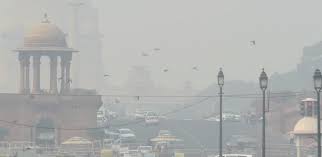![]() By: Shree1news, 07 NOV 2020
By: Shree1news, 07 NOV 2020
The national capital’s air high quality was recorded within the “extreme” class on Saturday morning as farmers in Punjab and close by areas continued to set their fields on fireplace to clear crop residue.
The Central government’s Air High quality Early Warning System for Delhi stated town’s air high quality is more likely to stay “extreme” on Diwali as properly.
Specialists stated whereas meteorological situations had been “reasonably” beneficial for dispersion of pollution, a “very excessive” variety of farm fires in Punjab was the first purpose for “extreme” air high quality.
In line with the Ministry of Earth Sciences’ air high quality monitor, SAFAR, Delhi’s general air high quality index (AQI) was 443 on Saturday morning.
An AQI between zero and 50 is taken into account “good”, 51 and 100 “passable”, 101 and 200 “average”, 201 and 300 “poor”, 301 and 400 “very poor” and 401 and 500 “extreme”.
PM10 ranges in Delhi-NCR stood at 486 microgram per cubic meter (µg/m3) at 9 am on Saturday, based on Central Air pollution Management Board (CPCB) knowledge.
PM10 is particulate matter with a diameter of 10 micrometers and inhaled into the lungs. These particles embody mud, pollen and mould spores. PM10 ranges beneath 100 µg/m3 are thought of secure in India.
The levels of PM2.5—finer particles which may even enter the bloodstream—had been 292 µg/m3 at 9 am. PM2.5 ranges as much as 60 µg/m3 are thought of secure.
Air Quality Early Warning System for Delhi stated the variety of farm fires in Punjab stays very excessive (round 4,000) which is more likely to affect the air high quality in Delhi-NCR and different components of northwest India.
It stated the AQI is more likely to stay within the “higher finish of ‘very poor’ class on November 13 and ‘extreme’ class on November 14 (Diwali)”.
According to the India Meteorological Department (IMD), the utmost wind pace was 14 kilometres per hour on Friday and the minimal temperature 11.eight levels Celsius.
Calm winds and low temperatures entice pollution near the bottom, whereas beneficial wind pace helps of their dispersion.
V.K. Soni, head of IMD’s environment monitoring analysis centre, stated, “A very large number of farm fires over Punjab is the primary reason for the extreme air quality in the region.”
SAFAR stated the share of stubble burning in Delhi’s PM2.5 air pollution was estimated at 21 per cent on Friday. It was 42 per cent on Thursday, the utmost to this point this season.
Last year, the contribution of stubble burning to Delhi’s air pollution had peaked to 44 per cent on November 1, based on SAFAR knowledge.
Source: A-N







 Finance
Finance






